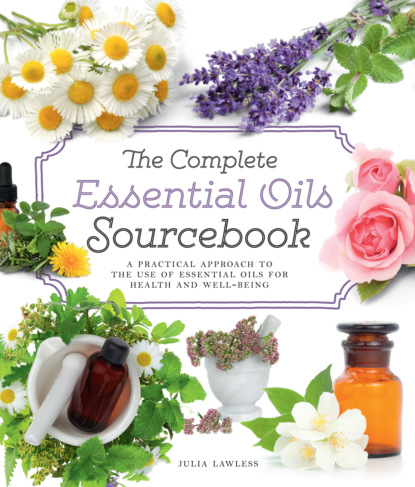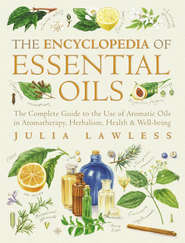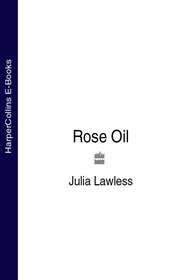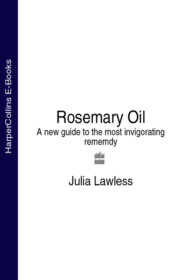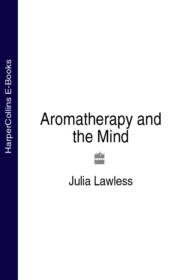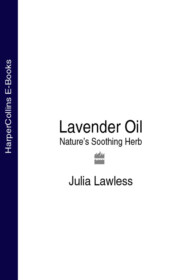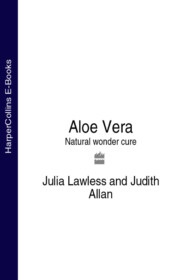По всем вопросам обращайтесь на: info@litportal.ru
(©) 2003-2024.
✖
The Complete Essential Oils Sourcebook: A Practical Approach to the Use of Essential Oils for Health and Well-Being
Настройки чтения
Размер шрифта
Высота строк
Поля
ACKNOWLEDGMENTS
ABOUT THE PUBLISHER
This early 15th-century manuscript shows the cultivation of the rose, already long-established at that time.
Preface (#ua1f42d25-06c7-5241-a2b9-22ec6c146de1)
THE LAST TWO DECADES of the 20th century have witnessed a remarkable renaissance of interest in, and practice of, natural healing methods. In recent years, such forms of treatment as medical herbalism, osteopathy, shiatsu, reflexology, acupuncture, and aromatherapy have all attained varying degrees of credibility in the eyes of health professionals, as well as among the general public. Of these, aromatherapy is among the most popular alternative or complementary forms of treatment available in the UK and other Western countries. Yet only half a century ago the therapeutic use of herbs and essential oils was frowned upon or even officially banned. Plant medicines were seen as something archaic and outmoded in comparison to the new pharmaceutical drugs, and in 1941, the British Pharmacy and Medicines Act made the practice of herbal medicine illegal. Fifty years later, the scientific world is reappraising the value of natural remedies: as the limited effectiveness, and unwanted side effects, of aggressively synthesized medications are being recognized, aromatic essences are coming back into their own once again.
But is the current fascination for aromatherapy just another fashion or fad, or is it part of a larger sociological and cultural movement? Firstly, many of the so-called “alternative” therapies, including aromatherapy, are not new or modern techniques. They are based on ancient medical systems that have been built up over thousands of years from accumulated empirical evidence. Medical herbalism, and the use of aromatic remedies in particular, are very much older forms of treatment than Western allopathic, or orthodox, medicine. Unlike many modern drugs, plant remedies have been tried and tested over generations, and any side effects or environmental consequences carefully noted. Herbal medicine and aromatherapy consequently represent a return to nature, being based on principles requiring ecological awareness. This corresponds with many people’s interest in “green” issues, and a widespread concern regarding the unknown effects of certain chemicals on the whole ecosystem and the long-term consequences of our exploitation of natural resources.
Melissa (lemon balm) is a plant much used by herbalists that also yields a valuable essential oil.
Perhaps the most feminine of all scents, roses have been used to make perfume and healing remedies since ancient times. The ancient Romans used the wild rose as a remedy for the bites of rabid dogs. Roses are still highly valued today and rose essential oil is very expensive.
The art of herbal distillation has been perfected over the centuries.
Secondly, alternative forms of therapy embrace a holistic approach to health. They focus on the well-being of the individual as a whole, including that person’s emotional or mental disposition. They are thus able to fulfill society’s need for some kind of psychological support during an era of instability. An aromatherapy massage, for example, can provide a valuable antidote to the fast pace of 20th-century life and help relieve many of the stress-related problems that are so widespread today.
PETITGRAIN
Thirdly, with regard to aromatherapy massage at least, it is a very comforting yet multifaceted form of treatment. During a treatment, the pleasingly scented aromatic oils produce both psychological and physiological effects as they are rubbed into the skin and absorbed into the bloodstream. In addition, the essential oils themselves are highly concentrated and easy to use, and require little or no preparation. This means that they can readily be employed by all kinds of people in a variety of ways to enhance their health and the overall quality of their lifestyle, rather than being limited to the hands of health professionals.
THYME
This book has been written partly as a companion volume to my previous book, The Illustrated Encyclopedia of Essential Oils. Whereas my earlier book focused on the essential oils themselves, including their extraction, chemistry, botanical features, and history, this book concerns itself solely with their therapeutic and cosmetic applications and concentrates on the diversity within the aromatherapy tradition as it is practiced today. It is above all a practical handbook, both for the practicing therapist and for more general use. Special emphasis is placed in the book on what I call “simple” aromatherapy—a basic, practical approach to self-treatment. It has always struck me as being a great pity that the whole realm of self-help using folk-medicine, which was once a natural part of family life, has been largely lost in Western culture. It is in this middle ground that aromatic remedies have such a lot to offer—playing their part in the home treatment of common everyday conditions such as period pains, headaches, eczema, and other skin complaints. Accepting responsibility for one’s own health and condition is also an affirmative statement. It encourages individual responsibility and opens a door to self-knowledge as well as a window into the natural world, for all essential oils are derived directly from plants. In fact the whole field of fragrant plants and natural medicine is a vast area. I have also found that, like gardening, aromatherapy has an addictive quality—once hooked you will find it is hard to let go, for there is always more to learn and discover.
CHAMOMILE
Introduction (#ulink_0d8b126e-4420-5892-aedd-66e5281b6f21)
I am delighted to introduce this new and beautifully designed edition of the Complete Essential Oils Sourcebook. It is now almost twenty years ago since I started to research and write the material for the first edition of this book, and since that time the popularity of aromatherapy has blossomed on an international basis! Pure essential oils can now be purchased on every high street and downtown center, and the use of natural aromatics in commercial cosmetics and toiletries has both expanded and diversified. This is because the remarkable therapeutic potency of these botanical oils has been increasingly validated by scientific research and by clinical tests, verifying their healing potential. This is especially true in the field of skin care, particularly in helping to combat ageing skin, as well as in the treatment of common infections and viruses.
The reality of climate change, as well as the impact of environmental and ecological issues, has also taken on a greater sense of urgency over these past two decades, largely as a direct result of our consumer culture. The need to pay attention to the type of products we choose to buy, their method of production, and their overall impact on the world in which we live now needs to be of paramount concern to anyone who cares about future generations.
Since essential oils are 100% naturally derived agents, functioning in a positive, holistic manner both within our own bodies and within our larger environment, their utilization represents an authentic route toward demonstrating a greater caring for our planet. However, it is important to source essential oils from companies that uphold responsible environmental policies, such as supporting re-forestation, avoiding the exploitation of endangered botanical species (such as Amazonian rosewood), and by employing ecological packaging materials. This philosophy goes hand in hand with adopting a lifestyle that respects and works together with nature, and in doing so, helps to preserve the beautiful globe on which we live.
How to use this book (#ua1f42d25-06c7-5241-a2b9-22ec6c146de1)
THIS BOOK IS FOR EVERYONE interested in the art and science of aromatherapy, from the professional practitioner to any newcomers to the subject. The book is divided into four main parts, covering every aspect of aromatherapy as practiced today.
The first part of the book introduces aromatherapy to the reader. It outlines the various aspects of aromatherapy, and focuses in detail on simple household uses of essential oils, skin and body treatments, and perfumery. Containing simple recipes and step-by-step instructions, Part 1 is designed to help the reader practice aromatherapy at home.
The second part of the book describes the approaches to, and techniques of, aromatherapy massage, and gives detailed, step-by-step descriptions with clear illustrations on how to give a full-body massage, therapeutic massage for local areas, and massage for special circumstances, such as sports massage.
Aspects of Aromatherapy provides a thorough introduction to the many uses of essential oils and describes simple home aromatherapy and perfumery. Aromatherapy Massage explains the massage techniques, while Medical Aromatherapy focuses on the medical uses of essential oils. The Index of Essential Oils is a comprehensive guide to all the aromatherapy oils referred to in the book, with clear, at-a-glance information about the uses and qualities of each oil.
In the appendix, notes on safety data show how to use the oils safely, and the chemical analysis is given for each oil. A nutrition sheet provides a quick source of dietary advice, a glossary explains all the medical and scientific terms used in the book, and there is a list of useful addresses telling the reader where to find the oils and further information about aromatherapy. Finally, there is an extensive list of books for further reference.
The third part of the book describes the ways in which aromatherapy is used in the field of medicine. The science of essential oils and the ways in which the oils are tested in the laboratory are explained, and the links between the chemical constituents of the various oils and their effects on the body are shown. It also shows how essential oils can be used safely and efficiently for medical treatment in the home. Remedies are divided into the different body systems, with clear instructions on the use of oils in treatment.
The fourth part of the book is an index of essential oils, listed in botanical name order. Each oil is described in detail, including its characteristics, actions, method of extraction, use in aromatherapy, scent qualities, and physiological, and psychological effects.
(#ua1f42d25-06c7-5241-a2b9-22ec6c146de1)
Aspects of aromatherapy (#ua1f42d25-06c7-5241-a2b9-22ec6c146de1)
Interest in aromatherapy is growing year by year. As more and more brands of essential oils and aromatherapy products are to be found in the shops there is a steady increase in the home use of aromatic essential oils. Professional aromatherapy treatment is now available in beauty salons, fitness clubs, and hairdressers, while essential oils are used therapeutically in modern hospitals as well as complementary health centers.
Aromatherapy involves using pure essential oils, derived from plants, in a huge range of health and beauty treatments, as well as for pleasure. In offering us a “natural” way of caring for our health, it is just one aspect of the growth of interest in all forms of alternative or complementary medicine and traditional home remedies. Modern (or allopathic) medicine is spectacularly successful in many ways, but increasing numbers of people feel that they would like to know about ways of preventing illness in the first place, and to be able to use simple, safe, and drug-free home remedies for ordinary, everyday ailments. There is also a growing feeling that in modern medicine we are treated as a collection of parts, some of which may have problems, rather than as a whole organism, and least of all as a person. In contrast, complementary medicine, of which aromatherapy forms a part, offers a way of being treated holistically—as a whole being in whom there are many aspects of a disease or illness and for whom individually tailored treatment is required.
In our search for ways of keeping fit and healthy without needing to use synthetic drugs, aromatherapy oils offer the advantage of their complete naturalness and their general safety and simplicity of use. They offer ways of preventing illness and treating ourselves at home, and in the hands of professional practitioners they can be used as part of a multifaceted holistic treatment.
In fact, of course, things are never quite as simple as they seem. Aromatherapy is complex in many ways. Firstly, it means different things to different people, and secondly the oils used, although simple in that each is the pure, natural product of a single plant, are complex and potent substances that need to be used with care, knowledge and experience.
The oils can be used simply for their fragrance and its effects on mood and emotion, but in professional practice their physiological effect is central. This is generally obtained through the oils being used in massage treatment, but some practitioners (with full medical qualifications) also use essential oils clinically in the tradition of the French pioneer, René-Maurice Gattefossé, in minutely prescribed oral doses and through inhalation.
“Volatile essences have healed people since the dawn of time.”
RENÉ-MAURICE GATTEFOSSÉ
The word “aromatherapy” literally means therapy through aroma or scent, without specifying the source of the scent. But aromatherapy in practice uses only essential oils, and no other form of scent. Its richness is that it has so many aspects, which are complementary to each other, and which may also overlap, but which are nevertheless distinct. In professional medical practice, it is the substances or oils themselves and their bio-chemical effects that are central, while in many home uses of essential oils it is the aroma that counts and the pleasure of the scent is the main reason for using the oils. Between these two extremes are cosmetic aromatherapy and massage, where the scent and the beneficial physiological effect of essential oils go hand in hand, and simple medical aromatherapy, which uses the oils’ many curative effects. Aromatherapy must be unique in having so many facets, and in offering such a wealth of pleasurable, practical, and therapeutic uses.
Approaches to aromatherapy (#ulink_345721d4-2f20-5891-92a8-387934d3f460)
THE THERAPEUTIC USE of essential oils covers a very wide spectrum. This is part of their charm and uniqueness. At their simplest, oils can be worn as natural perfumes, made into aromatic bath preparations or used in many ways as home remedies. They can also be combined with both home and professional massage to provide a very effective treatment for stress-relief. At the other end of the scale, specific botanical essences can be used by clinically trained therapists or doctors for the treatment of serious medical conditions.
Rose petals are a traditional ingredient in potpourri.
The ways in which aromatherapy can be practiced can be separated into five areas of specialization. Although it is impossible to draw hard and fast lines between these various aspects, classifications of this kind are helpful, at least in the short term, for the process of clarification and understanding. These different areas are: simple aromatherapy for home use, cosmetic aromatherapy, perfumery and the psychotherapeutic use of oils for the effects of their odors on the mind, massage using essential oils, and medical and clinical aromatherapy, where essential oils are used to treat medical complaints.
Simple aromatherapy
A basic approach uses aromatic oils in a wide range of methods, including vaporization, aromatic bathing, local massage, cosmetic creams, and steam inhalation, for first-aid purposes and in the treatment of common complaints. This approach is in the ancient tradition of herbal “simples”—home remedies or household secrets, originally passed on from generation to generation. It can be adapted by nurses and other professionals and used as an adjunct to medical treatment. As a type of preventive medicine, it can help to ward off infectious illness and promote general health and well-being.
“The Roses of Heliogabalus” by Sir Lawrence Alma-Tadema, 1836–1912.
Cosmetic aromatherapy
The use of essential oils for skin and beauty care is an ancient and specialized aspect of aromatherapy. There are records that show that many primitive cultures used natural aromatics as a means of adornment and as a way of enhancing their beauty. Indeed, many indigenous peoples still do so today. However, the earliest and richest associations concerning the cosmetic use of aromatic materials are to be found in the practices of the Ancient Egyptian civilization, some 5000 years ago. Aromatic herbs, gums and oils were incorporated into carefully formulated cosmetic ointments and other beauty preparations, as well as being employed in the embalming process. Seen in this light, the Ancient Egyptians were the original precursors of modern beauty therapists, especially those who use aromatic oils as part of their cosmetic treatments.
Psycho-aromatherapy and perfumery
The term psycho-aromatherapy is used to describe the use of the pyschotherapeutic benefits of essential oils, effected mainly by inhalation but also by other methods of application. In the practice of psycho-aromatherapy the ways in which botanically derived aromas can influence moods and emotions and help to induce certain states of mind are studied. This can be by bringing about a state of relaxation or through their energizing and stimulating effects. This contrasts with aromachology, in which both natural and artificial scents are studied for their therapeutic value, but principally for purely commercial purposes in the perfume industry. Nevertheless, psycho-aromatherapy does have a great deal in common with the art of perfumery, especially since all perfumes were originally made using natural aromatics, and since they both focus on the psychological effects of scent and require a high degree of olfactory discrimination and knowledge.
Aromatherapy massage
There are many benefits to be derived from combining massage with the use of essential oils. It is the main method adopted by professional aromatherapists working in the field of alternative health care. Aromatherapy massage has been largely influenced by the French pioneer, Marguerite Maury, whose research work was directly aimed at utilizing the healing and revitalizing properties of aromatics, especially through application to the skin. This approach is notably beneficial for the treatment of stress-related disorders and requires a substantial degree of training, both in acquiring massage techniques and in understanding the many and varied properties of the essential oils that may be used.
Другие электронные книги автора Julia Lawless
Rose Oil




 0
0





